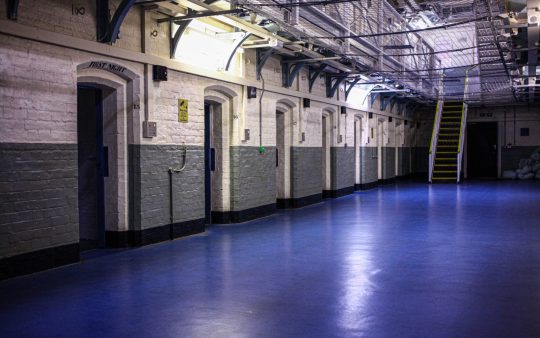#Shrewsbury prison
Text

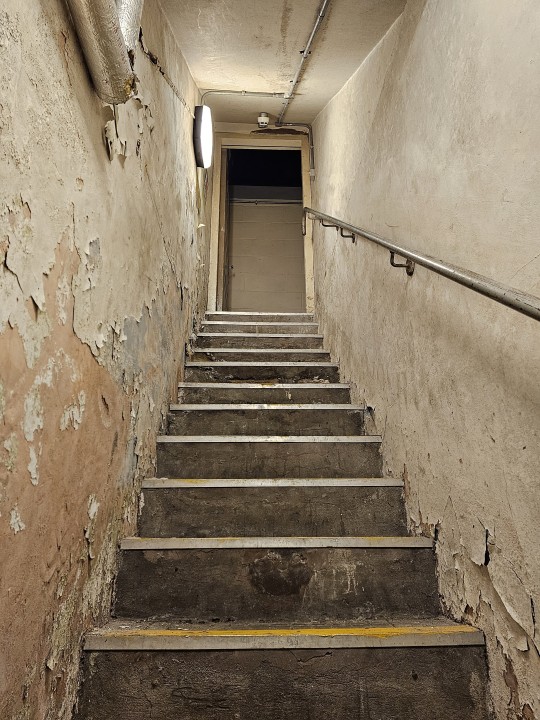
#prison#boiler room#shrewsbury#Shrewsbury prison#cellar#spooky#spooky cellar#horror aesthetic#horror#horrorcore#aesthetic#liminal#eerie#creepy#dark#outlast#liminalcore#eeriecore#outlast aesthetic#creepycore#eerie liminal#eerie aesthetic#eerie photography#stairs#creepy stairs#creepy staircase#ghosts#halloween#haunted#haunted aesthetic
239 notes
·
View notes
Text
I went on a Ghost Hunt at HMP Shrewsbury
I went on a Ghost Hunt at HMP Shrewsbury
I have always been interested in ghosts, spirits and the paranormal and a few weeks ago I finally got the chance to go on an organised ghost hunt.
It was at HMP Shrewsbury which was a Category B/C men’s prison, decommissioned in March 2013 it is now open to the public. The prison that can be seen today sits on top of the original Georgian prison, the remains of which are still accessible…

View On WordPress
2 notes
·
View notes
Text
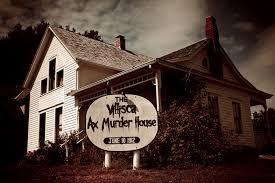
9 Terrifying American Murder Houses
From Amityville Horror to Jeffrey Dahmer’s one-bedroom, these murder houses are home to some truly brutal murders.
9. THE AMITYVILLE HORROR HOUSE
112 OCEAN AVE, AMITYVILLE, NY
When the deal is too good, start asking questions. In 1975, George and Kathy Lutz bought this sprawling Dutch Colonial on the south shore of Long Island at a bargain rate. The reason for the discounted price tag? Just 13 months earlier, previous resident Ronald “Butch” DeFeo slaughtered his parents and four younger siblings while they slept in their beds. It didn’t take long for the weirdness to begin. Demonic voices, oozing walls, cloven hoof prints in the snow. The Lutz family lasted just two months before fleeing 112 Ocean Avenue in the night.
8. THE HEX MURDER HOUSE
REHMEYERS HOLLOW RD, SHREWSBURY, PA
In 1928, John Blymire was convinced a reclusive neighbor named Nelson Rehmeyer had put a hex upon him. Believing the only way to break the curse was to track down Rehmeyer’s spell book and set it ablaze, Blymire rallied two buddies for a late-night visit. While the gang never found the book, they did find Rehmeyer whom they murdered and mutilated before setting his body on fire. In 2007, an effort was made to open the Hex House to the public, but the plan was eventually scrapped.
7. MOORE FAMILY AXE MURDER HOUSE
508 E 2ND ST, VILLISCA, IA
On a cool summer night in 1912 someone broke into this peaceful Iowa homestead and bludgeoned all six family members plus two houseguests with an axe. The horrific scene was discovered the following morning by a concerned neighbor. Numerous suspects were named in the case including a traveling minister and State Senator Frank F. Jones. Nevertheless, the murder remains unsolved.
6. KREISCHER MANSION
4500 ARTHUR KILL RD, STATEN ISLAND, NY
German entrepreneur Balthasar Kreischer built this sprawling mansion in 1885 as a symbol of his success in the brick making business. The good times were short-lived. By 1894, his company had crumbled and his youngest son had shot himself in the head. The decaying mansion sat empty for years until its groundskeeper used the property for a mob hit in 2005. Joseph Young strangled and stabbed his target before finally drowning the man in a garden pool. Young then hacked up the body and burned it in the mansion’s incinerator.
5. LIZZIE BORDEN HOUSE
230 2ND ST, FALL RIVER, MA
On August 4, 1892 Andrew Borden was thrashed with a hatchet while he dozed on the couch of his parlor. Andrew’s second wife Abby met an equally grisly end in the upstairs bedroom. While everyone in Fall River suspected daughter Lizzie of the crime, the local judge remained unconvinced. She was tried and acquitted of the murder one year later. Oddly, the home is now a successful bed & breakfast.
4. MANSON FAMILY MURDER HOUSE
10050 CIELO DRIVE, LOS ANGELES, CA
In 1969, members of the Manson Family shocked the nation when they broke into this L.A. estate and slaughtered Sharon Tate along with four other victims. The murderers wrote pig in blood across the front door. Numerous residents have since called 10050 Cielo Drive home including musician Trent Reznor, who recorded THE DOWNWARD SPIRAL there. In 1994, the original structure was razed and replaced with a new mansion, currently occupied by the creator of FULL HOUSE.
3. JEFFREY DAHMER’S APARTMENT
924 NORTH 25TH ST, APT 213, MILWAUKEE, WI
Cannibal killer Jeffrey Dahmer lured numerous victims to his nondescript one-bedroom, where he drugged and dismembered them in a brutal campaign of murder. Severed limbs were packed in the freezer for future consumption; torsos were dumped in a vat of acid. Police finally arrested Dahmer in 1991 after one of his prisoners managed to escape. The entire apartment building was torn down shortly thereafter.
2. JOHN WAYNE GACY’S HOUSE
8213 SUMMERDALE AVE, CHICAGO, IL
It’s always good to know your neighbors especially if you suspect them of murder. John Wayne Gacy buried dozens of bodies in the basement and backyard of his suburban home while neighbors casually went about their day. When Gacy’s wife complained of a putrid smell, Gacy blamed it on dead mice. By the time police nabbed the infamous killer clown and excavated his 8213 Summerdale Ave property, they uncovered 29 bodies.
1. GARDETTE-LAPRETE HOUSE
1240 BURGUNDY ST, NEW ORLEANS, LA
In the late 1830s, plantation owner Jean LePrete leased his French Quarter Greek Revival to a mysterious man from Turkey. The renter, known only as The Sultan had more than a few roommates. He arrived with a massive entourage of eunuchs and concubines. The house quickly became known for its lavish parties, with music and revelry carrying on into the night. One morning, a passerby noticed 1240 Burgundy was eerily quiet. Then he spotted blood seeping out of the door. When authorities entered, they found everyone inside had been murdered and dismembered. As for The Sultan? He was buried alive in the courtyard. To this day, the case remains unsolved.
#9 Terrifying American Murder Houses#ghost and hauntings#paranormal#haunted locations#ghost and spirits#haunted salem#myhauntedsalem#paranormal phenomena#ghosts#spirits#murder houses#axe murders#haunted#hauntings#haunting#supernatural
10 notes
·
View notes
Note
A big ask I know. But what is some evidence that the documentary conveniently ignored to push their survival narrative?
Evidence of the death of the princes is much less conclusive, because the only contemporary evidence we have are several chroniclers abroad and in England & Wales stating that the princes were murdered or were believed to have been murdered. There is more evidence that Lambert Simnel and Perkin Warbeck were impostors, though. From the top of my head: the Sétubal testimonies confessing Warbeck was not Richard of Shrewsbury, Maximilian I's own 1488 admission to Henry VII claiming he was duped by Margaret of York into backing an impostor (only to do the same again four years later), Perkin Warbeck's letter asking his mother in Tournai for money to pay his expenses in prison in England, and comments by foreign ambassadors who understood the situation was simply international politics.
For more precise scrutinising of the evidence on Lambert Simnel and Perkin Warbeck I really recommend Nathen Amin's Henry VII and the Tudor Pretenders. He never explicitly says his opinion but the evidence he presents clearly points to a logical conclusion.
Now, one truly has to ask why Langley & co decided to discard their earlier Da Vinci code theory that Edward V lived out his days as John Evans in a small Devon village and instead chose to go with the by now often beaten theory that Lambert Simnel was Edward V. It doesn't make sense because those symbols/glass panels were the only genuine new evidence they found (even if imo it's not conclusive to Edward V's survival). The rest was already known since the 1950s.
17 notes
·
View notes
Note
Sorry if it's a dumb question. But if people say Lambert or Perkin were the Princes, why did they wait so long to come back?
Richard stole their birthright slurred them their mother and sisters as a whore and bastards. So why the hell did they never appear in his reign and get an army? Yeah it's a short time and they were young but no one's asking them to fight. Plenty of men would've helped.
Like if everyone thought they were dead, Henry's sorta avenging them by killing Richard and marrying Elizabeth. He's the good guy! So why wait.
The best explanation I have is Richard was holding them, and would've kept them in prison until they died, but when Bosworth happened someone let them out.
I mean, if they lived, wouldn't taking two boys hostage, killing protective male family, and never letting them see their mother again, and never have any life at all, be pretty shitty behavior as it is?
So it's kind of a paradox. If Richard didn't kill them, even if they weren't Perkin or Lambert, he was expecting to leave them in jail forever. So he ruined their lives and was cruel for no reason. If he was ready to hurt two children, he sounds like the type of guy who would finish the job and kill them.
So if I follow the whole "they survived" theory through, Richard ends up sounding guilty anyway.
Well, do you know why Lambert Simmel's revolt never happened during Richard III's reign?
Because the rebellion was made by Ricardians.
It's Richard III's sister funding mercenaries led by Richard III's former Lieutenant of Ireland/nephew and his former best friend, landing on Richard III's stronghold and attracting Richard III's former supporters (the Harringtons, Broughtons, Scropes).
Lambert Simmel being Edward V. Makes. No. Damn. Sense.
As for Perkin Warbeck, the fact that he waited years speaks volumes on his authenticity. He was aware that this was an issue, hence his justifications about his brother Edward V being killed by people whom he does not name the sponsor before being put in custody by said killers who seemingly have no trouble killing a 13-year-old but think it's too immoral to kill a 10-year-old. Then they free him after a bunch of years in Flanders.
Two options: either they work for Richard III, in which case they should have no trouble freeing him after he gets killed. Either they work for the Tudors/Tudor-linked, in which case he wouldn't ever be free. What convince me that Perkin Warbeck isn't Richard of Shrewsbury is his own weird version of events, not whatever his opponents said.
And indeed, it's to vindicate Richard III but less as an innocent man than a victim of his time. In the long run, they can't canonize him, considering many of his past deeds. But what they wanna do is pin the portrayal of someone unfairly treated by his contemporaries and posterity. Using a famous mystery in which one can muddy the waters enough to instigate doubts is great for them because then, they can avoid talking about his career as a duke, his actions as a general or his very real ambitions and aspirations.
I do not get their hyperfixation on Richard III & morality. I personally outgrew it when I was 16 years old. Richard III doesn't interest me for that. Their picture of a martyred (?), progressive (??), proto-socialist (???) Duke of Gloucester is so strange it's a bit fascinating.
#Edward V#Richard of Shwresbury#Richard III#war of the roses#Perkin Warbeck#Lambert Simmel#And frankly#if that make them happy to think he didn't do it (TM)#good for them#but what I can't stand is them distorting very clear historical events like the Stoke campaign for their little crusade#I fear some writers/journalists/amateurs/ will even present that as a theory to the wide public when it's bs
14 notes
·
View notes
Text


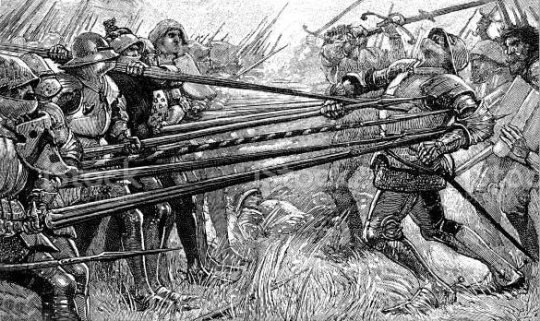
September 14th 1402 saw a Scots army led by 4th Earl of Douglas defeated at the Battle of Homildon Hill by English army led by Percy ‘Hotspur’.
A little known battle, one of many between the Douglas Clan and the English Percy’s. Some sources have this down as a “Skirmish” others, like Wiki have the numbers involved as 10,000 Scots against 15,000-20,000 in the English Army, so a bit more than a skirmish, but I’m inclined to think the numbers have been exaggerated in the latter estimates. This had all the ingredients of a classic Border Reiver clash that the Douglas family were famous for.
In August a Scottish raiding force thousands strong under Archibald, Earl of Douglas, crossed the border, penetrated as far as Newcastle and then turned back to cross the Tweed at Coldstream with its plunder. Hotspur moved to intercept and the Scots, determined not to leave their slow-moving stolen cattle behind and make for Scotland at full pelt, camped in an apparently strong position on Homildon Hill.
The Percy’s had thoughtfully recruited Welsh archers, who from a distance took a heavy toll of the mass of men and horses on the hill. Some of the Scots horsemen charged, saying: “Better to die in the mellay than be shot down like deer”. All perished. It has been suggested that Douglas hesitated to signal the advance of his main force, and when he did, it was too little too late.
Eventually the Scots fled, but many were caught and slaughtered, and few got away. Douglas himself was captured, with five arrow wounds in his body and the loss of an eye.
Fortunately for the Scots, Henry IV had problems of his own with internal problems and a Welsh rebellion so the English failed to press home whatever advantage they had gained, the Percy’s were to release the prisoners, within a year they themselves were in open revolt against Henry and many including Douglas decided to join forces with him. Indeed, Douglas fought, at Hotspur’s final fight at the Battle of Shrewsbury, such were the blurred lines back then.
Hotspur was killed and Douglas was again captured. Hotspur’s body was salted and quartered for display at York and other towns. Perhaps this is how this particular Douglas gained the epithet “Tyneman” meaning loser in Scots, although some historians say the moniker was this may be a reference to his great-uncle Sir Archibald Douglas.
The second pic is the ancient Bendor Stone, around this that many of the Scots were killed, it serves as a monument to those that fell.
8 notes
·
View notes
Text
Thursday Thrill: Rave Revolution Easter Weekend Extravaganza!

Get ready to groove to the beats of the century as global rave scenes light up this Easter weekend! From historic prisons turned party zones to legendary clubbing hubs and sustainability-driven EDM marathons, the dance floor is calling your name. Let's dive into the ultimate Easter rave guide!
Locked Up
31 March
Prepare for an extraordinary Bank Holiday experience as Crooked House Production unveils a groundbreaking event at Shrewsbury Prison. This immersive festival promises a unique blend of culture, entertainment, and exploration.
Join us this weekend for the Crooked House raveathon, with convenient coach travel options from Birmingham or Lichfield for just £12 per person return. Skip the hassle of driving and hotel bookings and enjoy a night out worry-free. Featuring top DJs like Low Steppa and Huxley, alongside state-of-the-art installations. This event is set to be a massive dance music riot.
Tickets for the Crooked House Production Bank Holiday event at Shrewsbury Prison are available now, with early access and group deals on offer for a limited time. Don't miss out on this sell-out event!
Tickets and More Info
House of Legends
30 March
House of Legends is back and ready to reignite Birmingham's clubbing scene at XOYO! Prepare for a 12-hour marathon dance event this Easter bank holiday, where we'll take you on a nostalgic journey through the biggest sounds of the 90s, Acid House, Bassline, Club Classics, and House music.
Join us for a nonstop party starting at 3pm on Saturday, where one ticket grants you access to the best dance music. Here is a chance to reunite with old friends, and meet new ones. Spread across four arenas, XOYO will be buzzing with energy from Birmingham's most prominent clubbing brands dating back three decades.
In the Main Arena, dance music royalty awaits with DJs like Alex P. Also join by Brandon Block, Leeroy Thornhill x Prodigy, and more. Arena two hosts The Rooftop Rave featuring Clinton Shawe, Chad Lewis, and others. Arena three welcomes the Crunch Reunion crew, and Arena four is all about Broad Street clubbing with B15 PROJECT and more.
While tickets are still available for purchase, why not try your luck to win a pair through WhatsOn's social media channels? Don't miss out on this epic rave, especially if you were disappointed by Gatecrashers' cancelled shindig at the townhall. House of Legends promises an unforgettable night of pure dance music bliss that you won't want to miss.
Tickets and More Info
DGTL Amsterdam
29 – 31 Mar
Get ready for an epic three-day EDM marathon as DGTL returns to the NDSM Docklands for a non-stop rave experience like no other. This is where like-minded people come together for the biggest dance-off of the year.
For those craving a massive weekend of hardcore techno and the finest house music, look no further than Amsterdam. DGTL is set to take over the city with one of the finest EDM, art, and production festivals of the year. It's not just about the music; it's about sustainability too. DGTL is the ultimate sustainability flagship festival. It's showing the world that large-scale events can succeed while also caring for the planet.
Spread across three days, DGTL boasts a lineup of elite DJs from around the globe. However alongside phenomenal homegrown talent from the Netherlands. From Enzo Siragusa to Kerri Chandler, Boys Noize to Âme & Dixon, the festival promises an unforgettable party experience.
Don't miss out on Easter weekend's cracking festivities. let's pack your bags, grab your passport, and get ready for the time of your life.
Tickets and More Info
Read the full article
0 notes
Text
Chatsworth House 16th Century
The history of Chatsworth begins with Elizabeth Talbot, Countess of Shrewsbury, better known as Bess of Hardwick.
Sir William Cavendish (1501-1557) and Bess of Hardwick (1527-1608)
The history of Chatsworth begins with Elizabeth Talbot, Countess of Shrewsbury, better known as Bess of Hardwick. A native of Derbyshire and from a modest background, she grew to become the second most powerful woman in Elizabethan England after the Queen. Bess married 4 times, and it was with her second husband, Sir William Cavendish, that the Cavendish line which continues today was established.
Sir William Cavendish came from Cavendish in Suffolk, and prospered during the 16th century as one of King Henry VIII's commissioners for the dissolution of the monasteries. When he married Bess in 1547 she persuaded him to sell the former monastic lands he had amassed and move to her home county. Despite its isolated location and the risk of flooding, they bought Chatsworth manor for £600 in 1549, and in 1552 began to build the first house on the site. The Hunting Tower, built in the 1580s, still stands on the hill above Chatsworth.
After Sir William died in 1557, Bess married Sir William St. Loe (d.1565) and lastly, in 1567, George Talbot, 6th Earl of Shrewsbury (c.1522-90). Queen Elizabeth I appointed Shrewsbury as custodian of Mary, Queen of Scots, who was a prisoner at Chatsworth at various times between 1569 and 1584. Her lodgings were on the east side of the house where the rooms, although changed beyond recognition, are still called the Queen of Scots Apartments.
Bess also built Hardwick Hall, her surviving masterpiece. One of the greatest houses of the Elizabethan age, it has a unique collection of 16th and 17th-century embroideries, tapestries and furniture. It belonged to the Cavendish family until 1957, when it was given to the government in-lieu of death duties, and is now a National Trust property.
Harvard Referencing:
CHATSWORTH. (N/A) 16th Century. [Online] Available from: https://www.chatsworth.org/visit-chatsworth/chatsworth-estate/history-of-chatsworth/16th-century/ [Accessed: 18th September 2023]
1 note
·
View note
Text


#aesthetic#liminal#eerie#creepy#dark#liminalcore#eeriecore#the backrooms#prison#shrewsbury prison#shrewsbury#liminal spaces#liminal aesthetic#liminal photography#prison cells#horror#horrorcore
211 notes
·
View notes
Text
history of chatsworth
the chatsworth house has been home to
sixteen generations of the devonshire family for nearly 5 decades
it all begins with elizabeth talbot better known as Bess of hardwick (1527-1608)
she grew to become the second most powerful woman in england behind the queen. she ended up marrying 4 times during her life and with her second husband sir william cavendish that the cavendish line was established. she persuaded sir William to move to her county and so in 1549 they bought Chatsworth manor for £600 and in 1552 they began to build the first house on sight. this is now called the hunting tower and is still stood today on the hill above Chatsworth.
after sir William died in 1557 bess married sir William st Leo in 1567and queen Elizabeth appointed Shrewsbury custody of Mary queen of Scots who was a prisoner at Chatsworth at various different times between 1567 and 1584.
bess also built hardwick hall which is 'one of the greatest masterpieces of the elizabethan age' this stayed in the family until 1957 until it was given to the government and is now a national trust property.
sir William Cavendish (1501-1557)
sir William was a knight, mp, and courtier. he was also one of king henrys viiis commissioners
History of Chatsworth (no date) Chatsworth House. Available at: https://www.chatsworth.org/visit-chatsworth/chatsworth-estate/history-of-chatsworth/ (Accessed: 09 October 2023).
0 notes
Text
Bess of Hardwick & Sir William Cavendish

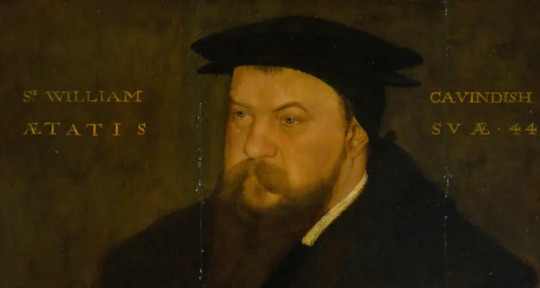
Bess of Hardwick (Elizabeth Talbot, Countess of Shrewsbury) was a native of Derbyshire. She was the second most powerful woman in England at the time after Queen Elizabeth I. The Cavendish line was established with her second husband, Sir William Cavendish. When they married, Bess convinced William to sell some of his land and in 1549, they bought Chatsworth manor for £600. In 1522 they built the first house on the property.
Queen Elizabeth appointed Bess as a custodian (person who is responsible for taking care of) of Mary, Queen of Scots. Mary, Queen of Scots was kept prisoner at Chatsworth at a few points between 1569 and 1584.
Bess of Hardwick, Countess of Shrewsbury (c.1527-1608) (no date) Chatsworth House. Available at: https://www.chatsworth.org/visit-chatsworth/chatsworth-estate/history-of-chatsworth/bess-of-hardwick/ (Accessed: 03 September 2023).
Sir William Cavendish (1501-1557) (no date) Chatsworth House. Available at: https://www.chatsworth.org/visit-chatsworth/chatsworth-estate/history-of-chatsworth/sir-william-cavendish/ (Accessed: 03 September 2023).
0 notes
Text

Chatsworth House is famously known for its quality of art, landscape and hospitality. It is known for its revolve and passion around fashion and trends coming from each generations. It is located in Derbyshire Dales and was bought in 1549 for £600. It is owned by the Devonshire family ( duke and duchess).The house and the gardens were first constructed in 1555 by Sir William Cavendish and Bess of Hardwick. The history of Chatsworth begins with Elizabeth Talbot ,Countess of Shrewsbury , better known as Bess of Hardwick. Famous faces in history such as Mary Queen of Scots stayed as a prisoner at Chatsworth House between 1569-84. The snake is important to Chatsworth House due to it being designed by William Kent in 1733. The reason for the decoration is that a snake is a part of the Devonshire families crest.
0 notes
Text
Bess of Hardwick: Four Times a Lady
Horace Warpole
Four times the nuptial bed she warm’d,
And every time so well perform’d,
That when death spoil’d each husband’s billing,
He left the widow every shilling.
Fond was the dame, but not dejected;
Five stately mansions she erected
With more than royal pomp, to vary
The prison of her captive
When Hardwicke’s towers shall bow their head,
Nor mass be more in Worksop said;
When Bolsover’s fair fame shall tend,
Like Olcotes, to its mouldering end;
When Chatsworth tastes no Can’dish bounties,
Let fame forget this costly countess.
From The Letters of Horace Warpole:
On Bess of Hardwick: She was daughter of John Hardwicke, of Hardwick in Derbyshire. Her first husband was Robert Barley, Esq. who settled his large estate on her and her heirs. She married, secondly, Sir William Cavendish; her third husband was Sir William St. Lo; and her fourth was George Talbot, Earl of Shrewsbury, whose daughter, Lady Gracek married her son Sir William Cavendish.
0 notes
Text
Chatsworth primary research
Chatsworth comprises a Grade I listed house and stables, a 105-acre garden, a 1,822-acre park, a farmyard and adventure playground, and one of Europe’s most significant private art collections.
It has been home to sixteen generations of the Devonshire family for nearly five centuries. Each has contributed to its careful evolution and preservation, creating the house, garden, estate, and collections we enjoy today.
youtube

The house has gone through many changes since the first house was built on the site by Bess of Hardwick and her second husband William Cavendish in 1549.
The manor was bought and had a sum of £600; in today's money, the value is £165,000. The construction of the original house began in 1552 and built it up, but the only surviving and complete structure from this period was the Hunting Lodge on the top of the hill.
www.chatsworth.org. (2023). History revealed. [online] Available at: https://www.chatsworth.org/news-media/news-blogs-press-releases/history-revealed/ [Accessed 15 Aug. 2023].
During the Civil War, the house was occupied by both sides as the 3rd Earl fled to the continent and did not return to Chatsworth until the Restoration of the monarchy. By this time, the Elizabethan rooms were beginning to look outdated and were also becoming increasingly unsafe to be around.
Under the 4th Earl, the house underwent a series of desperate need repairs, which he enjoyed immensely and added more details to the house than originally intended before so it looks more new and interesting. The new Chatsworth was finished in 1707.
During the nineteenth century, you could see dramatic changes to the house with the addition of the remarkable and iconic North wing by the 6th Duke. This transformed Chatsworth into what we now see to this day.

Cavendish: 1505- 57
Cavendish was an English politician, knight and courtier who held public office, accumulated a considerable fortune, and became one of Thomas Cromwell's "visitors of the monasteries" during the dissolution of the monasteries.
He died in 1557, and after another marriage which ended in her husband dying in 1565, Bess married for a fourth and final time to George Talbot, Earl of Shrewsbury. When he was appointed the custodian of Mary, Queen of Scots by Elizabeth I.
Between the years 1569- 1584, Chatsworth served to keep the Queen as a prisoner. Her rooms on the east side of the house are still called the Queen of Scots Apartments today, even though the rooms have fully changed around since then as it decays over time.

Bess of Hardwick: 1521- 1608
Elizabeth Cavendish, later Elizabeth Talbot, Countess of Shrewsbury died in 1608. She was a notable figure in Elizabethan English society. Through a series of well-made marriages, she rose to the highest levels of English nobility and became enormously wealthy. She was reportedly a shrewd businesswoman, increasing her assets with business interests which includes mines and glass-making workshops.
Bess was married four times. Her first husband was Robert Barley, he died at the age of 14 or 15 on the 24th December 1544. Her second husband was the courtier William Cavendish. Her third husband was William Loe and her last husband was George Tabolt 6th Earl of Shrewsbury.
Bess joined Mary at Chatsworth for extended periods in 1569, 1570, and 1571, during which time they worked together on the Oxburgh Hangings. This is a needlework bed hangings that are held in Oxburgh Hall in Norfolk. They both worked on this during the period of Mary's captivity in England.
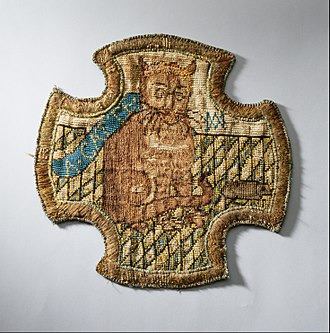
It was not until Mary was removed to another keeper, Sir Amias Paulet, that she got into the trouble that would lead ultimately to her execution. Previous to the Queen's change in custody, Shrewsbury and Bess were separated for good.
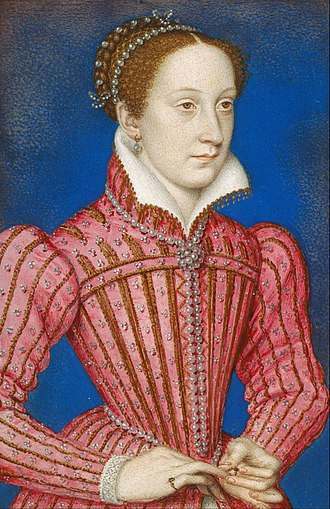
Mary Queen of Scots: 1542- 87
Mary died in 1587, She was the queen of Scotland from 14th December 1542 until her forced abdication in 1567. Mary was six days old when her father died and she inherited the throne. During her childhood, Scotland was governed by regents, first by the heir to the throne, James Hamilton, Earl of Arran and then by her mother, Mary of Guise. In 1548, she was betrothed to Francis, the Dauphin of France, and was sent to be brought up in France, where she would be safe from invading English forces during the Rough Wooing. She married Francis in 1558, becoming queen consort of France from his accession in 1559 until his death in December 1560.
She issued a proclamation accepting the religious settlement in Scotland as she had found it upon her return and retained advisers such as James Stewart, Earl of Moray who is her half-brother and William Maitland of Lethington are governed as the Catholic monarch of a Protestant kingdom.
James Hepburn, 4th Earl of Bothwell, was generally believed to have orchestrated Darnley's death, he was acquitted of the charge in April 1567. The following month, he married Mary. Following an uprising against the couple, Mary was imprisoned in Lochleven Castle. On 24th July 1567, she was forced to abdicate in favour of her one-year-old son. After an unsuccessful attempt to regain the throne.
Chatsworth History | Peak District Online. (n.d.). Peak District Online. [online] Available at: https://www.peakdistrictonline.co.uk/chatsworth-history/ [Accessed 8 Jun. 2023]. - link -more about the History.
www.chatsworth.org. (n.d.). Bess of Hardwick, Countess of Shrewsbury (c.1527-1608). [online] Available at: https://www.chatsworth.org/visit-chatsworth/chatsworth-estate/history-of-chatsworth/bess-of-hardwick/. - Bess Hardwick History
National Trust for Scotland (2019). National Trust for Scotland. [online] National Trust for Scotland. Available at: https://www.nts.org.uk/stories/mary-queen-of-scots. - Queen of Scots history.
www.historyofparliamentonline.org. (n.d.). CAVENDISH, Sir William (c.1505-57), of Northaw, Herts. and Chatsworth, Derbys. | History of Parliament Online. [online] Available at: https://www.historyofparliamentonline.org/volume/1509-1558/member/cavendish-sir-william-1505-57 [Accessed 8 Jun. 2023]. - William cavendish
Firth, C.H. (2020). The Life of William Cavendish, Duke of Newcastle, to which is Added The True Relation of My Birth, Breeding and Life.
Vivien, D. and Upton, S. (2002). Chatsworth : the house. London: Frances Lincoln.
Plaidy, J. (2006). The Captive Queen of Scots. Crown.
Rosalind Kay Marshall, Scottish National Portrait Gallery, National Library Of Scotland and Museum, R. (2000). Queen of Scots. Edinburgh: Mercat.
0 notes

